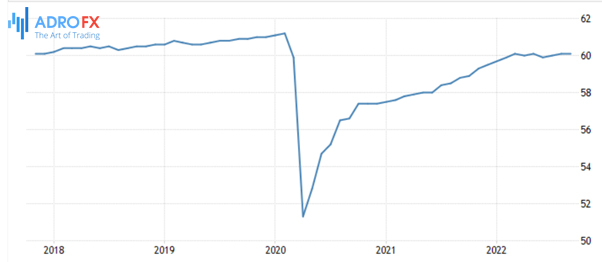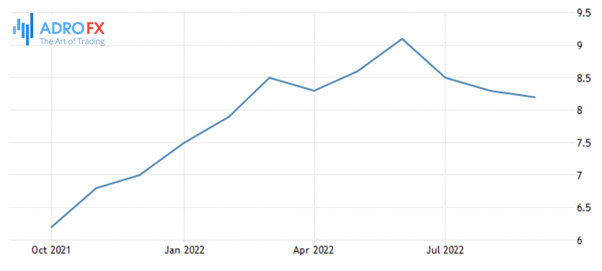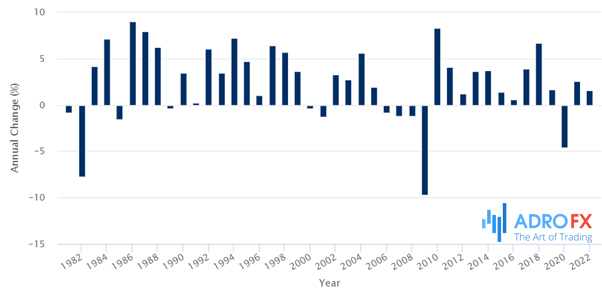Key Economic Indicators and How to Use Them in Forex Trading

Financial markets as well as the economy of any country in general are not static. It experiences periods of growth and decline, which together make up economic cycles. Such fluctuations influence the global trends of various financial instruments. However, periods of growth and decline do not last the same length, so to determine the current stage of the cycle or the forthcoming trend of its change, it is necessary to be able to use various economic indicators.
When making decisions about investing in a particular asset, one should analyze not only a specific company but also the situation of the economy as a whole, because it is known that in different phases of the economic cycle companies in different industries may show different stability and efficiency. Therefore, it is important to assess the dynamics and trends of macroeconomic indicators. Such indicators characterize the general state of the economy and its trends. They can be published either in government reports or calculated by independent organizations on certain dates. Sometimes the publication of indicator values is comparable in its influence on the stock market to the influence of the companies' financial reports on their stock quotations. But in the case of the indicators, their influence is more significant. One of the notable examples is the release of the U.S. inflation data for January 2022, which launched a sell-off mechanism in the U.S. market. The disadvantage of such statistics is their publication with a certain time lag, i.e. they reflect changes that have already taken place. That is why those indicators which can show possible future changes in the economy are of great importance. Such indicators are usually called leading indicators.
In this article, we will learn about different types of economic indicators, take a closer look at the most popular ones, and go through their practical importance for traders.
Key Economic Indicators
The mechanism of market evaluation and forecasting is closely linked to the dynamics of the six major economic indicators. These are the indicators that can exert significant pressure on the Forex market and seriously influence future developments. Below we are going to analyze these indicators and explain the peculiarities of their usage.
Economic indicators are usually released by government apparatuses or private organizations. These indicators often play an important role in currency market developments. Such data can be used effectively for region-specific analysis. For example, economic reports on health care measures can go in addition to government policies in the current review.
In most cases, it is enough for an experienced analyst to look at economic indicators to conclude developments in the foreign exchange market. Reports on various indicators are published at predetermined times. These plans are available for public viewing. As a rule, they are published by different analytical companies in the form of summary tables. Therefore, we can learn about the release of important news long before it is made public. At the moment of release, the interpretation of signals is important.
All that is required from the trader is to correctly identify the quality signals that can give the market momentum from the signals that are not. If after the publication of the data we carry out an analysis of forex and make sure that the economy of the published data is experiencing a decline, then the trader should take adequate measures for asset management in the current market conditions.
As you have already understood, we should be interested in current events in the economy of any country or the world economy as a whole. Important indicators such as unemployment, housing construction, and the state of affairs in the government can have a direct impact on the forex market. If a country's economy is booming, the demand for its national currency will increase.
If the country is characterized by high political instability and unemployment, if there is a high rate of inflation, it will have a negative impact on the national currency. Some indicators may not work in certain conditions, so when you analyze forex, you should take into account the peculiarities of developments in the publication of various kinds of fundamental data.
What Are Economic Indicators?
First of all, let's look at what economic indicators are. These are indicators of the economic activity of a country or even an entire economic zone (for example, the European Union). These indicators provide comprehensive information about the current state of the economy and its prospects.
The first thing worth noting is that these indicators are very much related to the business cycle of the economy. The business cycle, the cycle of development, is an important concept of the modern world. The cycle shows the general dynamics of economic activity, with ups and downs. For example, a downturn in business activity for more than two quarters, the economy is called a recession.
It is customary to divide existing economic indicators into three types:
- Leading
- Lagging
- Coinciding
Leading indicators are indicators that usually change before the economy as a whole. That is, they serve as signals of future changes in the economy, such as a change in the phase of the economic cycle, and are used to forecast economic activity. This is especially important when the economy is coming out of recession or approaching its crisis phase.
Lagging indicators reflect economic changes that have already occurred. They are based on past price fluctuations and give an idea about the historical data of a particular market, economy, or asset. These indicators can be used for confirmation of the patterns and reliability of earlier made forecasts. Lagging indicators are sales data, inflation index, etc.
Coincident indicators show the current state of the economy and change simultaneously with economic trends (GDP, employment, etc.).
It should be noted that the assignment of indicators in the last two groups is very conditional. Among the examples given, different analysts define the type of one or another indicator differently. As for the leading indicators, everything is more unambiguous here.
Unfortunately, there is no single specific set of indicators that can be used to predict the economic cycle or exchange rates. If such a set of indicators existed, the person who discovered it would become the first dollar trillionaire.
That's why we are going to share with you only the most common economic indicators, which, one way or another, affect the currency market and which often help to predict the movement of a particular currency.
The main thing you need is the economic calendar and a good nerve because the volatility at the moment of publishing economic indicators is off the charts.
Employment Report
The employment rate is one of the most important indicators in any country's economy, and it is an indicator that any trader who wants to trade on economic statistics should keep an eye on. Job creation charts tell a lot about the state of a country's economy. This is because the more people employed, the higher the future consumer spending, which is what makes up the lion's share of GDP.

The U.S. Bureau of Labor Statistics releases its employment rate report on the first Friday of the new month at half past nine in the morning, U.S. Eastern time. Most very powerful institutional traders take this data into account, and that is why this event always brings tremendous volatility to the market.
The report includes indicators such as hourly earnings, Non-Farm Payrolls in the U.S. economy, and the unemployment rate. The most important indicator here is the unemployment rate. When it rises, the U.S. dollar most often falls sharply. When it falls, the dollar strengthens.
Inflation
The level of inflation also has a very considerable effect on the financial markets. Inflation is the percentage change in prices of goods and services over some time. Together with the unemployment report, inflation is one of the most important indicators.

The world's central banks, and the U.S. Federal Reserve, in particular, are trying to keep a certain inflation target to keep the economy healthy. The inflation target in the U.S. is around 2%, and today we are seeing U.S. dollar inflation well above that target, approaching 10%. This could and probably will cause a worldwide recession in the coming years.
What Types of Inflation Reports are There
The most common inflation reports are the Consumer Price Index (CPI) and the Producer Price Index (PPI).
Like employment data, these statistics are also released by the U.S. Bureau of Labor Statistics, and these reports are also published once a month. It is published around the middle of the month at 9:30 a.m. The data takes into account the previous month. The CPI report is more important than the PPI and is usually released a little earlier.
The Consumer Price Index (CPI) tells the value of a basket of hundreds of goods or services which are important to the average person. The weight of each good or service is the same as the weight of that good or service in the expenditures of the average person.
CPI statistics also have many sub-indices that will tell you the state of prices for things like electricity, or food - separately.
The release of inflation statistics very often causes great volatility in the markets. The importance of the report cannot be underestimated, because the rate of inflation determines monetary policy. When the inflation rate rises, it often causes the need to tighten monetary policy, which leads to a sharp rise in the exchange rate.
On the other hand, a weak inflation rate, or even the phenomenon of deflation, makes it necessary to soften monetary policy. For example, Japan fell into the deflation trap, and that period went down in history as the "lost decade" - the Japanese economy was not growing, and the stock market was falling.
How Can One Predict the Inflation Report?
Rising material and commodity prices eventually translate into rising producer input prices. The Producer Price Index (PPI) is a metric of the prices of more than three thousand items of goods and materials used in manufacturing. It also includes the prices of raw materials.
Since the PPI is released a day or two before the main PPI, traders can get ahead of the curve and bet on whether the PPI will rise or fall according to the PPI. After all, the PPI is the wholesale price of goods, a change in their price later translates into a change in the price on the store shelf.
It is also worth noting that the dynamics of the PPI index may depend on the weather. The fact is that the weather affects, for example, crop yield, and it affects the dynamics of producer prices. Also, these two indices are highly correlated and, therefore, the strategy of trading the PPI based on PPI data is very, very justified.
Retail Sales
Another economic statistics metric that a trader should keep an eye on is retail sales.
The sales level report speaks to the estimated value of all sales in the U.S. retail sector, and this data is published by the U.S. Department of Commerce, around the second week of each new month. Like previous data, this metric is published at half past nine in the morning.

The sales report is also one of the most important indicators of the economy and has a great influence on the level of the currency. This is because the sales figure indicates the purchasing power of the population, which in turn affects the Gross Domestic Product of a country.
Since retail sales data is published monthly, it can give you clues as to what to expect from the quarterly GDP report. Higher retail sales usually mean higher earnings for companies, which leads to more investment in the U.S. economy and an increase in the U.S. dollar index. But a decline in U.S. retail sales has a negative effect on the U.S. currency.
For the sake of predicting the level of sales, there were cases of counting occupied parking lots in shopping malls from satellites. Such technology has been used by hedge funds to stay at least momentarily ahead of other traders and investors.
This is also why the retail sales report is important: when one is confident about the well-being of the country and one's personal well-being, it goes without saying that one will spend more capital than in a bad period. Therefore, the U.S. retail sales report is very important from the point of view of anticipating the condition of a colossus like the United States.
The GDP Report
Among all economic statistics, the GDP report is the key and most important, economic indicator. It speaks to the sum of the value of all goods and services that have been produced in the country over a period of time. Ownership of a good or service is irrelevant here, as long as only services and goods produced or provided within the borders of the state are counted. For example, all Volkswagen cars that were produced in the States would be counted in the U.S. quarterly GDP.

The report is prepared by the U.S. Bureau of Economic Statistics. The report takes place in three approaches: two preliminary reports and one final report.
It is the preliminary report that affects the currency market. It is released about a month after the reporting quarter is over. So, the report for Q2 is usually released in July. GDP is one of the most important economic indicators.
The U.S. Bureau of Economic Statistics recalculates all important indicators more than once, and the forecast of the final value is also adjusted more than once. The final report is published about a month after the second preliminary report.
The GDP report is calculated using the total expenditures method.
As for the shares of these indicators, as a rule, the share of the total consumption of U.S. citizens is about seventy percent.
How to trade this indicator? When U.S. GDP is growing faster than forecasted, and the actual value is higher than the forecasted value, the U.S. dollar usually rises. In economic calendars, it is the preliminary report that is indicated, as it has the greatest impact on the markets.
In the chart, you can see the correlation between the preliminary U.S. GDP level and the value of the U.S. dollar:
It used to be that U.S. GDP data was the key economic indicator affecting the U.S. dollar. Today, the correlation coefficient to the dollar index has become much lower. This is due to the detachment of financial markets from the real economy, and in part to the fact that U.S. GDP has begun to trade based on other economic data, meaning that the dollar is now changing in value faster than U.S. GDP is changing.
Short-term and Long-term Bond Yields
The correlation of bond yields with different maturities helps to track current economic sentiment and understand benchmarks for future developments. You can compare short- and long-term bond yields by constructing the so-called yield curve. It is also important that it is the zero-coupon yield is taken into account. Most often, government bonds with different maturities are used to plot the no-coupon yield curve. But such analysis can also be done for other bonds of the same credit quality as any issuers.
The bond market is much larger in volume than the stock market. It is the opinion of its participants that correlates more with the reality of the economy. If investors expect inflation and interest rates to rise, they are unlikely to be willing to lend to the government on current terms for the long term. Accordingly, the price of long bonds declines while yields rise. And vice versa.
The shape (slope) of the yield curve suggests the current state and possible future global changes in the economy.
Transportation Index
The transportation sector is one of the most important sectors of the economy, transporting people and goods. The development of transport infrastructure contributes to the growth of trade turnover. In addition, the dynamics of demand for transport services is a leading indicator of economic development, as it characterizes the level of business activity.
Global Transportation Index (Freight Index, TSI) is calculated by the U.S. Bureau of Transportation Statistics monthly as a ratio of the current month and the previous month's shipments. Actual values are published on the official website of the Bureau.
The dynamics of the transport index value inform about the increase or decrease of transport services in comparison with the previous month. With economic growth increases the volume of production and demand for goods and services. To produce more goods and deliver them to consumers, companies require additional services for the transportation of goods: both finished products and raw materials and various components.
Thus, the index reflects the response of transport service providers to the needs of the economy in the transportation of goods and changes earlier than the indicators of the economy itself (the volume of industrial production, sales, GDP, etc.).

The chart above shows a graph of the transport index at the time of writing.
As you can see in the graph, 2019-2020 saw a significant drop in the index amid a crisis due to the COVID-19 pandemic, which resulted in millions of job losses, a drop in trade, and a drop in oil and commodity prices. For 2020, the index fell 4.6 percent, but in 2021 it rose 2.6 percent as the economy began to recover.
Thus, the index acts as a leading indicator of overall economic performance. The rising trend suggests that freight volume is growing, retailers are stocking up, and manufacturers are ordering raw materials and inputs in anticipation of improving economic conditions.
Interest Rate
Interest rates are among the main characteristics used in fundamental analysis. This feature allows you to find out the earnings potential of investing in the currency of a country. The increase or decrease in interest rates affects the growth or decline of the currency.

With the change in the rate, the Central Bank can regulate the price of the currency, which directly affects the level of inflation, as well as the attractiveness of the currency for investors. For example, if the Central Bank of the country increases the interest rate, the national currency begins to be of interest to investors, which causes the growth of the rate. At the same time, it should be remembered that higher interest rates have a negative impact on the economic situation as a whole because credit becomes more expensive for local companies, which prevents them from intensive development.
A state's central bank usually raises the interest rate when inflation increases. This decision harms the state's economy, causing the central bank to lower interest rates. Thus, the central bank of any country either raises or lowers interest rates from time to time.
Tips for Trading Economic Indicators
The abundance of macroeconomic indicators does not allow you to create one single correct strategy for all time. However, there are certain tips, the knowledge of which provides you with increased profits:
- Buy the rumor. The best way to buy currency on rumors of news releases.
- Sell the fact. You should get rid of the currency you bought the moment the relevant facts emerge, which indicate the continuation of the falling trend in value.
- Data on macroeconomic indicators is published in leading financial magazines and is available online on the official sites of government agencies and private organizations.
- A good trader pays attention to other factors, which include the balance of trade, the ratio of exports to imports, the geopolitical situation, and similar things. In fact, it becomes mandatory to watch the news to have an idea of what is going on.
Trading on macroeconomic indicators is ideally supplemented by the use of specialized tools in indicators. A combination of several methods is a prerequisite for success.
About AdroFx
Established in 2018, AdroFx is known for its high technology and its ability to deliver high-quality brokerage services in more than 200 countries around the world. AdroFx makes every effort to keep its customers satisfied and to meet all the trading needs of any trader. With the five types of trading accounts, we have all it takes to fit any traders` needs and styles. The company provides access to 115+ trading instruments, including currencies, metals, stocks, and cryptocurrencies, which make it possible to make the most out of trading on the financial markets. Considering all the above, AdroFx is the perfect variant for anyone who doesn't settle for less than the best.








